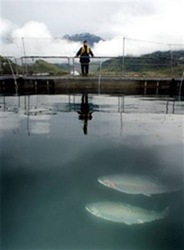 Fish farms have been on the ascendancy for some time, what with obscene pressure on wild fish stocks, and the Medical community advocating the eating of fish “two to three times per week.”
Fish farms have been on the ascendancy for some time, what with obscene pressure on wild fish stocks, and the Medical community advocating the eating of fish “two to three times per week.”
Migratory fish can be augmented by hatcheries, but table fish that don’t migrate have to be raised in the ocean in enclosures. Genetic tinkering of any lifeform, whether animal or plant, is still a hot topic – both in the general populace, and even among fishermen.
The Trout Underground’s post of the triploid rainbow trout record showed the divide that exists even within our little community.
Get used to it.
A small story on the BBC illustrates how “table” fish stocks are unwittingly being tampered with – purely by accident. Seals are hungry, and a big net full of salmon looks mighty appealing, in gorging themselves – they’ve released 157,000 genetic salmon into the wild last year.
In February, the Scottish Salmon Producers’ Organization (SSPO) said the number of salmon escaping from Scottish fish farms into the wild had halved.
It told a ministerial group that 157,000 fish escaped last year compared with about 300,000 in 2002.
The SSPO at the time contested claims that escaped farmed fish outnumbered wild ones.
The story lacks much detail, but 157,000 fish likely attempted to mount something (or vice versa) – so that lunker you landed last week was a wild fish? Prove it.
Half of the world’s sea food is now being farmed,” Mr MacMillan told Newsnight reporter Liz MacKean. “In order to have sea food available to consumers, it has to come from aquaculture.”
That is an amazing quote. I can only wonder what a lab engineered salmon thinks is his home stream, and who do I have to pay to get them all programmed to come to my house?
Technorati Tags: aquaculture, fish farm, farmed salmon

Pingback: No, it was a WILD Triploid | blinkfiles